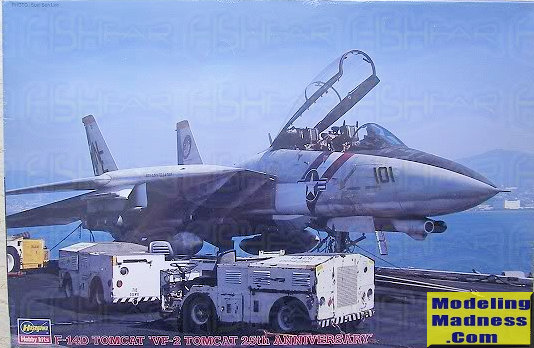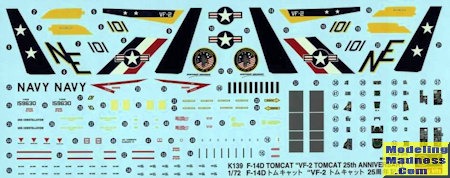
Hasegawa 1/72 F-14D "VF-2 25th Anniversary"
| KIT #: | 04099 (K139) |
| PRICE: | 2200 yen SRP |
| DECALS: | One option |
| REVIEWER: | Scott Van Aken |
| NOTES: | 1998 Limited reissue |

| HISTORY |
The Grumman F-14 Tomcat is a supersonic, twin-engine, two-seat, variable-sweep wing fighter aircraft. The Tomcat was developed for the United States Navy's Naval Fighter Experimental (VFX) program following the collapse of the F-111B project. The F-14 was the first of the American teen-series fighters, which were designed incorporating the experience of air combat against MiG fighters during the Vietnam War.
The F-14 first flew in December 1970 and made its first deployment in 1974 with the U.S. Navy aboard USS Enterprise (CVN-65), replacing the McDonnell Douglas F-4 Phantom II. The F-14 served as the U.S. Navy's primary maritime air superiority fighter, fleet defense interceptor and tactical aerial reconnaissance platform. In the 1990s, it added the Low Altitude Navigation and Targeting Infrared for Night (LANTIRN) pod system and began performing precision ground-attack missions.
Throughout most of its life, the F-14 was hampered by the TF-30 engines originally designed for the F-111B. These caused some issues and did not allow the full utilization of the Tomcat's design capabilities. It was planned on using F-401 engines but issues with the engines and budget concerns shelved that. It wasn't until many years later that the F-110 engine was installed in some F-14A airframes making those F-14A+ and later F-14B aircraft. The upgraded F-14D had these same engines and upgraded digital avionics with about half of the F-14D production being reworked F-14As.
In the 1980s F-14s were used as land-based interceptors by the Islamic Republic of Iran Air Force during the Iran–Iraq War, where they saw combat against Iraqi warplanes. Iranian F-14s reportedly shot down at least 160 Iraqi aircraft during the war, while only 12 to 16 Tomcats were lost; at least half of these losses were due to accidents.
The Tomcat was retired from the U.S. Navy's active fleet on 22 September 2006, having been supplanted by the Boeing F/A-18E/F Super Hornet. The F-14 remains in service with the Islamic Republic of Iran Air Force, having been exported to Iran in 1976, when the U.S. had amicable diplomatic relations with Iran.
| THE KIT |
Asdemanded, the panel lines are engraved and the kit offers the ability to havethe flaps and slats deployed. In fact, to do it otherwise will require a bit ofsurgery to be done on the slat tracks. You can also position the glove vanesopen or closed. Again, some surgery is needed for the closed position. All F-14shad them wired in the closed position after it was realized that they didn't really do anything and were an additional maintenance hassle. You also have the ability to have the speed brakes and entrance steps/ladderopen or closed, and two different tails, though one set is not for thisparticular boxing. So much has the F-14 been modified and updated over the yearsthat you really need to have photographs of the aircraft that you are modelingto get everything right.
 As required by its price, this kit comes with a small fret ofetched metal. These bits are for the interior, canopy and exhaust. The metalworkis very well done and should really enhance your Tomcat. For this kit, they supply the instructions for the 'F-14D Super Tomcat' boxing and an addendum sheet that shows the D model differences. This includes a resin lower nose piece and new gun vent doors. The
As required by its price, this kit comes with a small fret ofetched metal. These bits are for the interior, canopy and exhaust. The metalworkis very well done and should really enhance your Tomcat. For this kit, they supply the instructions for the 'F-14D Super Tomcat' boxing and an addendum sheet that shows the D model differences. This includes a resin lower nose piece and new gun vent doors. The  instructions arevery well done as you would expect. They offer color callouts based on Gunzepaint as is the norm with Hasegawa over the last decades. Every option anddifference between the aircraft on the decal sheet is given so that you can do aproper job of things.
instructions arevery well done as you would expect. They offer color callouts based on Gunzepaint as is the norm with Hasegawa over the last decades. Every option anddifference between the aircraft on the decal sheet is given so that you can do aproper job of things.
For markings, we have just one aircraft, the box art plane in a retro scheme of light gull grey over white with full color unit markings and insignia.
| CONCLUSIONS |
You can add this one to a growing list of Hasegawa limited reissue kits. I guess it is a good way to do business as they seem to sell rather well. I'm surprised at how well these molds have held up. The final result of the build is a superb model of an important US fighter.
| REFERENCES |
http://en.wikipedia.org/wiki/F-14_Tomcat
June 2016
Thanks to me for this one, eh?
If you would like your product reviewed fairly and quickly, please contactme or see other details in the